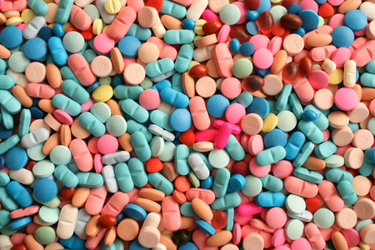6 Emerging Trends In Pharmaceutical Tablet Coatings
By Mukul Joshi, MarketsAndMarkets

Tablets have consistently held significant importance as a dosage form in the pharmaceutical and nutraceutical industries. The introduction of tablet coatings initially aimed to conceal the unpleasant taste and odor of drug formulations. Nevertheless, tablet coatings have evolved to play a pivotal role in improving the overall appearance, functionality, and stability of tablets.1
The increasing aging population and the rise in chronic disorders such as cancer, diabetes, and cardiovascular disorders have led to a higher demand for drug therapies and production.1 Also, the market for generic drugs is on the rise; according to the FDA, generic drugs account for nine out of 10 prescriptions filled, with over 32,000 generic drugs approved as of January 2023.2 Consequently, there has been a global surge in the demand for coating drug formulations to meet these growing needs. Let’s look at six key emerging trends as well as the challenges to keep in mind as you move into the future.
1. The Growing Adoption Of Modified-Release Formulations
Modified release plays a crucial role in delivering active ingredients in a controlled and delayed manner, resulting in prolonged therapeutic effects. This necessitates the use of specialized coating techniques such as enteric coating, film coating, and sustained-release coating for modified-release tablets.3 Pharmaceutical companies are continuously developing innovative modified-release products, driving the sustained demand for specialized tablet-coating excipients on a global scale.
2. Nutraceutical Products Are Using Controlled-Release Coatings
The rise in lifestyle-related disorders and poor dietary habits has led to increased consumer awareness and interest in nutraceutical products and dietary supplements. Tablet coatings play a crucial role in nutraceutical tablets by enabling controlled release, masking odors and tastes, and enhancing visual appeal and branding. As the consumption of nutraceutical tablets continues to grow, there is a simultaneous increase in the demand for tablet coatings on a global scale.
3. New Drug Coating Excipients Are On The Rise
In recent years, numerous polymers have undergone extensive research and analysis to determine their suitability as coating excipients, offering a range of advantages such as enhanced mechanical stability, aesthetic appeal, brand recognition, improved storage conditions, and optimized flow properties. By polymer type, the cellulosic polymer segment is expected to hold a significant market share through at least 2025.4
That being said, regulatory agencies like the FDA and EMA impose rigorous manufacturing and quality control guidelines on the pharmaceutical industry. Tablet coatings play a pivotal role in meeting these stringent regulations by ensuring uniformity, stability, and accurate dosage of active pharmaceutical ingredients. Pharmaceutical manufacturers are actively investing in enhancing their drug coating technologies to ensure compliance with the highly regulated pharmaceutical market. This focus on technological advancements is driving the development of new drug coating excipients, consequently increasing their demand in the industry.4,5 The discovery of increasingly lipophilic active pharmaceutical ingredients, macromolecules, and biological actives has also resulted in accelerating the demand for well-evaluated excipients and development of new ones, as the current available excipients may not be sufficient to support the newly discovered active pharmaceutical ingredients.
4. The Rise Of Liquid-/Solvent-Free Coatings
Liquid coating technologies have been utilized significantly in coating solid dosage forms. However, in recent years, a shift toward continuous manufacturing and solvent-/liquid-free coating is emerging. The use of solvent-based coating technologies is declining due to their toxic/flammable nature, high cost, environmental impact, and the health-risks posed to equipment operators.4,6 To overcome these drawbacks, liquid-/solvent-free coatings are being actively pursued. Solvent-free coatings can reduce process time and cost by avoiding the expensive and time-consuming process involved in solvent disposal. Additionally, the solvent-free coatings do not require drying in most cases and can be applied to heat-sensitive drug formulations.4,6
5. New Process Analytical Technology Tools Enable Efficiency
Another emerging trend is the introduction of new process analytical technology (PAT) tools being used for real-time monitoring and data acquisition during film coating operations in solid dosage forms. Traditionally, many PAT tools, including spectroscopic techniques, imaging techniques, and microscopic techniques, have been deployed for monitoring the film coating operations. Recently, Raman spectroscopy technology has undergone improvements, rendering it more user-friendly, offering enhanced calibration stability, and achieving a more compact form factor. Furthermore, these innovations have facilitated the scalability of Raman technology by effectively reducing the overall cost associated with its acquisition and implementation.7,8
Likewise, a research group at Rutgers University has conducted a comprehensive evaluation of advanced multi-point NIR spatially resolved spectroscopy (SRS) probes. These probes deliver precise and rapid measurement capabilities. The remarkable precision and efficiency of this sensor technology have enabled a near-perfect inspection rate of tablets passing through a tablet press, reaching an impressive throughput of 200,000 tablets per hour.8
6. An Increasing Focus On Nanocoating Tech
Furthermore, vendors in the tablet coating market are also increasingly focusing on research and development using nanotechnology for improving excipients’ capabilities. Nanocoating can improve drug release profiles by controlling the release rate and improving the bioavailability of the active pharmaceutical ingredient (API). Additionally, the use of nanocoating technology can enable the incorporation of various functional materials, such as polymers, antioxidants, antimicrobial agents, or flavoring agents, onto the tablet surface.9
Notable Tablet Coating Company Developments
Some key players in the tablet coating market include Colorcon (U.S.), Sensient Technologies (U.S.), BASF (Germany), Evonik Industries (Germany), Dupont de Nemours (U.S.), and Ashland Global Holdings (U.S.).1 These companies are actively engaged in research and development activities related to tablet coating excipients and are introducing new and advanced coatings in the market. Here are a few examples of their strategic initiatives and real-world products:
- Colorcon has developed and launched the Nutrafinish Film Coatings portfolio, which includes label-friendly and titanium dioxide-free coating products for the nutraceutical industry.10
- Evonik Industries has introduced EUDRATEC Fasteric releases, an advanced oral drug delivery technology that offers enteric protection followed by rapid homogenous release, thereby enhancing the effectiveness of drug targeting in the upper small intestine.11
- Corel Pharma has unveiled Colorcoat Rapid, a new-generation polyvinyl alcohol-based ready-to-use film coating designed for pharmaceutical applications.12
Vendors in the market are consistently investing in research and development of new coating excipients with the introduction of new drug formulations.
Tablet Coating Challenges To Keep In Mind As You Move Into The Future
Requirements in tablet coating change with every new drug formulation in order to maintain drug consistency and ensure optimum delivery and patient safety. The significant capital investment tied to frequently changing tablet coating requirements can limit manufacturers' flexibility and scalability. It may be challenging to adapt to market fluctuations, changes in demand, or shifts in product formulations without incurring additional costs or disruptions across coating technologies and machinery. This hampers the entry of small-scale vendors with limited financial capabilities.
Moreover, addressing the high cost4,13 associated with the microencapsulation process across sustained release formulations is also a key challenge. Microencapsulation materials often need to be customized and, at times, need to be carried out at industrial scale instead of pilot scale. As a result, the overall cost associated with coating a tablet using a microencapsulation process often increases, which limits the use of such coatings across drug products to those that have a high value or where economies of scale can be applied or for drug products that are not possible without sustained-release coatings.
Regulatory authorities or government policies often implement price controls to enhance affordability and availability of vital medications for the public. However, these controls can result in decreased profitability for drug manufacturers. Since tablet coating adds extra expenses to the manufacturing process, reduced profit margins may impede the allocation of resources to tablet coating technologies and advancements.
Final Thoughts
According to a new analysis by MarketsandMarkets, the global tablet coating market has a projected compound annual growth rate (CAGR) of 5.6% and is expected to reach a value of $969.1 million by 2025.4 The Asia Pacific region is projected to be the fastest-growing market due to the outsourcing of drug manufacturing activities to specialized contract manufacturing organizations, the establishment of drug coating and manufacturing companies in emerging countries across Asia Pacific, and the presence of a substantial number of generic drug producers in China and India.4
The tablet coating market, a dynamic sector within the pharmaceutical industry, is experiencing robust growth propelled by the increasing growth in pharmaceutical production, growing adoption of modified release formulations, a surge in generic and nutraceutical production, and the increasing focus of pharmaceutical companies on quality compliance and manufacturing guidelines. With a promising future ahead, the tablet coating market is expected to play a vital role in delivering safe, effective, and visually appealing solutions to the patients who need them.
References
- https://pharmaceuticalmanufacturer.media/pharmaceutical-industry-insights/latest-pharmaceutical-manufacturing-industry-insights/acg-trends-in-tablet-coating/
- https://www.fda.gov/drugs/guidance-compliance-regulatory-information/fda-drug-competition-action-plan
- https://www.researchgate.net/publication/360776645_A_brief_review_on_recent_advancement
_of_tablet_coating_technology - https://www.marketsandmarkets.com/Market-Reports/tablet-coatings-market-150774403.html
- https://www.pharmaceuticalcommerce.com/view/modified-release-formulations-give-new-life-to-drugs
- Pharmaceutical Tablet Film Coatings | PharmaCentral | Materials and Knowledge Platform
- https://nexocode.com/blog/posts/predictive-analytics-in-pharmaceutical-manufacturing/
- https://www.pharmtech.com/view/implementing-process-analytical-technology
- Development of High-Drug-Loading Nanoparticles - PubMed (nih.gov)
- https://www.colorcon.com/markets/nutritional/coatings/nutrafinish
- https://central-south-america.evonik.com/en/evonik-launches-new-eudratec-technology-to-improve-solubility-of-oral-small-molecules-171504.html#:~:text=In%202020%2C%20Evonik%20launched%20EUDRATEC,require%20
advanced%20drug%20delivery%20solutions. - https://www.corelpharmachem.com/news/launch-of-faster-film-coating-colorcoat-rapid/
- Microencapsulation: Advantages and disadvantages > PharmaCampus
About The Author:
 Mukul Joshi is a team leader at MarketsAndMarkets. He has a bachelor’s degree in biotechnology, chemistry, and computer sciences, as well as a master’s in business administration. With six years of experience in market research, he specializes in areas such as medical devices, life sciences, pharmaceuticals, and laboratory automation and instrumentations.
Mukul Joshi is a team leader at MarketsAndMarkets. He has a bachelor’s degree in biotechnology, chemistry, and computer sciences, as well as a master’s in business administration. With six years of experience in market research, he specializes in areas such as medical devices, life sciences, pharmaceuticals, and laboratory automation and instrumentations.
